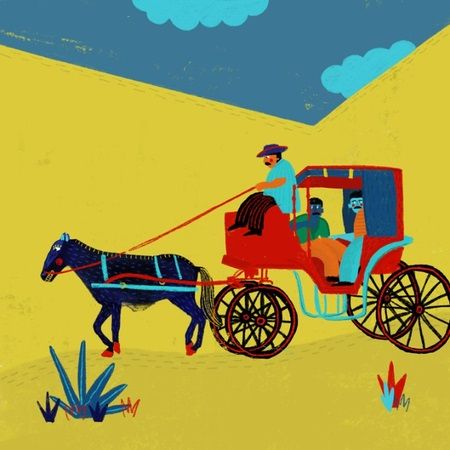Traveling in the colonial era: an inter-oceanic axis
The Mexico-Veracruz route was the first way in which New Spain communicated with the Spanish Empire, perhaps the most attractive route.

Although much of the road network we know today dates back to colonial times, its origins can be traced back to ancient Mexico. The gaps and trails through which the indigenous peoples passed were taken up again by the colonizers to connect the viceregal capital with the port of Veracruz. From 1530 onwards, the inhabitants of these new lands soon set about rebuilding this road to speed up transit, introduce wagons, and replace the indigenous porters (or tamemes).
Although the Mexico-Veracruz route was the first road in a form that allowed New Spain to communicate with the Spanish Empire, the geographical characteristics of the territory and its extension -more than 4 million square kilometers with areas of the altiplano, coasts, mountains, and peninsulas-, as well as the economic activities of the colony and foreign trade with the metropolis, conditioned the construction of new routes. Another factor was the population concentration in the center of the territory that privileged communications in this area, added to the urgency of having efficient land traffic that worked as a sort of commercial artery, taking Mexico City as a starting point.
The viceroyalty capital also communicated with the port of Acapulco, forming an inter-oceanic axis between the latter and Veracruz, perhaps the most attractive route from an economic point of view. The royal road facilitated trade between the Orient and the Spanish Empire, thanks to the fact that the Manila Galleon and the Nao de China docked at the port of Acapulco every year, from which porcelain, ivory, or silk were disembarked in exchange for the Novohispanic silver. The oriental products were taken to the capital and from there to the port of Veracruz with destination to the metropolis, also embarking articles and raw materials produced in the colony.
Other important royal roads were the one that linked Mexico with Puebla, which reached Guatemala through Oaxaca. Similarly, with the discovery and exploitation of silver after 1550, the route connecting the mining centers to the viceroyalty's capital was built, which was designed so they could travel-heavy carts that transported the metal, tools, quicksilver, and other important inputs for mining, allowing the expansion of the border in the north of the territory and connecting cities like Guanajuato, Zacatecas, Chihuahua and Santa Fe with the viceroyalty's capital. Also, from this main route, branches were built towards Valladolid, Guadalajara, San Luis Potosi, and Monterrey.
However, these roads were not free of problems and their state of conservation wasn't always the best, making them sometimes impassable for wagons or mule trains, due to natural obstacles such as riverbeds, ravines, and slopes, or the neglect and abandonment they were in. The bad conditions turned the transit through these arteries into real periples that could take days and forced the use of a variety of types of transport, from mules to small barges.
Due to these difficulties, cargo transport during the colonial era was very complicated because during the first years there were not enough mules or horses, so the tameme was used to load the goods. Later, the wagon and the metal wheeled carts pulled by mules and driven by muleteers were introduced.
As for the transport of passengers, it is known with precision -thanks to the stories of Baron Alejandro Von Humbolt- that they traveled in carriages, litters, or on horseback. As up to now, these transfers had stopovers and travel time depending on the distance from the destination. A trip from Mexico to Guadalajara using a vehicle with four available places took about 12 days and included 11 stops in cities such as Queretaro, Celaya, or Zapotlanejo.
Traveling was a luxury since in addition to being expensive, the expenses of sleeping in any posada had to be considered, and in the case of the route leading to the mines in the north, insecurity had to be considered as well. These problems were not exclusive to New Spain or the colonial era, for as seen elsewhere and at other times in history, the limitations are similar.
Source: SCT




